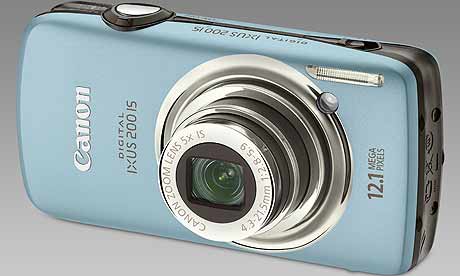
The Canon Digital IXUS 200 IS
The IXUS is, at least, the right sort of place to start. As with other IXUS compacts, the 200 IS looks chic and feels solid. The f/2.8 lens goes from a 24mm wide-angle to 120mm telephoto, there are ISO speed ratings from 80 to 1600, shutter speeds as long as 15 seconds, and a maximum resolution of 4,000 x 3,000 pixels (12MP). But there isn't a T-W rocker for zooming: the 200 IS has a tiny knob in front of the shutter button, and there's no separate viewfinder for old-school photographers like me.
The back of the 200 IS looks something like a classic Nokia mobile phone: there's a circular four-way controller with a button at its centre, and wing-like buttons on each side. A lot of functionality has been implemented using these, rather than the touchscreen. Canon claims this gives you the best of both worlds. I reckon you're paying for both the touchscreen and the buttons without getting the value from either.
Some touch functions are useful. For example, you can touch the screen to tell the camera where you want it to focus, and it's easier to use icons to set obscure modes (Aquarium, Beach, Foliage, Fireworks, Snow) rather than a jog dial. But using a gesture to move from one picture to another seems a bit pointless when you've got a mini-controller.
And although the picture quality is excellent for a point-and-shoot compact, 12MP is pushing it for the tiny 1/2.3 sensor. (With the G11, for example, Canon has gone backwards to 10MP from the G10's 14.7MP, and the 200 IS is trying to extract more pixels per square centimetre than the G10.)
Still, the pictures are sharp and rather neutral, without the warm richness that I've noticed (and, to be honest, enjoyed) in some Canon cameras. The shots are slightly warmer than ones from the Nikon CoolPix used for comparison purposes, but they make the Nikon look wrong. If you bought a 200 IS, then I think you would be happy with the results. But it seems to me that the touchscreen doesn't deliver enough benefits to justify the £329 suggested price, and there are better-value compacts even at the discounted price of £250.
Pros: well made; good specification; great lens; touchscreen makes some things easier.
Cons: mainly button operated; touch screen bumps up the price; LCD looks grainy.
canon.co.uk